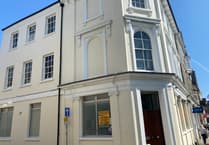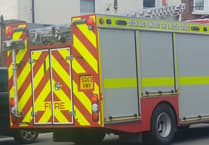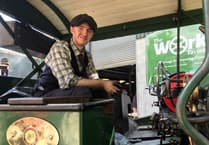TWO friends from Tavistock experienced what life has to offer on one of the greatest motoring adventures on the planet and have compiled updates especially for Times readers along their journey.
Chloe Brockington, 27, and Joe Goode, 35, set off on July 19 and were attempting to travel through approximately 20 countries, crossing 10,000 miles of desert through Europe to Asia in a small, second hand vehicle completely on their own with no back up, no support and no set route.
Joe writes:
So you find us now on day 21 of our journey. After a smooth exit from Turkmenistan, which was quite unexpected I might add, we entered Uzbekistan. As we passed through we stayed a night in Bukhara then another in Samarkand; ancient cities which lay along the old trade route between China and the Mediterranean, otherwise known as the Silk Road. We loosely found ourselves following this route for some time and we would continue.
As we moved towards Tajikistan and the mighty Pamir highway, I was starting to reflect on the things I had read prior to departure: The length of the road is 1,252 kilometers between the Tajikistani cities of Dushanbe and Osh through the Pamir Mountains; the road is heavily damaged in places by erosion, earthquakes, landslides, and avalanches; the Pamir highway is mostly one-lane and driving mistakes can have deadly consequences because the road is small and goes along deep valleys; no barrier stands between the road and the cliffs; the decaying roads make travelling difficult and dangerous with lack of any rest stop plastic sheds; the high elevation of the highway is no stranger to high winds — another gruelling danger while driving on weathered cliffs, making road closures quite frequent.
Great...
We arrived in Dushanbe, Tajikistan, quite late after a long day’s drive from Uzbekistan. It had been great there but the intrigue, fear and excitement of the next leg had now taken hold — could it be as treacherous as they say? We were about to find out!
Working on the basis of ‘expect the unexpected’ the next morning we stocked up with fuel, food and as much water as our cars could carry — it was about to get very real.
The first day saw us into the mountains. Our plan had been to take the more northern route as it was reported to be a slightly less dangerous yet scenic alternative. Best of both worlds we thought. However, like most best laid plans, this was to be changed quite dramatically, in this case by a very nice curator at the second highest botanical garden in the world. Bit random you might say but as events go on this rally it seemed fairly normal.
To better explain this event: we had stopped in Khorog which is the start of where things get interesting. From here you can take the more northern, tamer route as we’d planned, or you can head south through the Wakhan valley. The southern route borders both Afghanistan and Pakistan and also boasts more treacherous roads and higher altitudes, but has some of the greatest landscapes on the planet. It’s also described as ‘Death Valley on steroids’. However, we were in 1,000cc cars designed to commute around cities and this, coupled with the strong desire to live, we decided to press on towards the more northern route.
Our last stop as we left Khorog was this botanical garden. Being the second highest in the world it had to be worth a look – sorry to report there were no Triffids on this occasion.
What they did have was a tiny room with a very nice curator/information desk attendant. We quizzed her on the next leg of our journey. Ten minutes later we left her office with a map containing notes, which included 11km of sand pits and water crossings because our planned route was closed, it was the Southern Wakhan valley for us.
The next five days served up some of the most awe inspiring, challenging yet rewarding events of my life — there is nothing like driving on a sheer mountain pass at 3,500m to test your nerves!
We set off from Khorog to find the first few miles a mixture of paved and unpaved roads, largely having traveled on paved up to now it was quite a novelty to see a rough track. Villages we passed through greeted us like celebrities with families coming out to wave us on and children chasing the cars. Though they see 4x4’s passing through, our small, inappropriate European city cars with all their stickers and equipment strapped to the roof must have been quite a spectacle.
Things started to get interesting and we knew the road was on the change when we arrived at a fork. The map told us to take a left – something that we questioned about 100m in as it decided to go vertical, and with tight hairpins climbing a mountain. It looked like a donkey track!
We double checked and proceeded onwards. Gaining and keeping momentum on a hill such as this proved very difficult. It was a matter of necessity however as grinding to a halt would have meant rolling all the way back to the bottom to start again.
It was at the top of this pass (which I’m happy to report we nailed on the first attempt) that I really started to properly appreciate how good our little car was. Already having covered 129,000-miles, this little 1L Polo packed to the gills with equipment had just pulled us up the side of a mountain.
The coming days really did take its toll though — but l’ll come back to that a little later.
Camping along this stretch of the rally proved interesting too. The altitude really pulled the temperature down at night, which was great in some respects as drinking hot bottled water to keep hydrated was becoming somewhat of a mental battle — it seems like the smallest of things but you’d be surprised what a difference a cold drink in a hot desert makes to your day.
It was jackets/thermals by night though and once again all of our camping equipment was performing beautifully. Finding campsites however wasn’t such a great success; on the rare occasion that you found anything that resembled a flat or viable place to pitch it turned out to be something very different. For instance our stunning mountain top pitch turned out to be a graveyard. Night two, an area cordoned off with rocks by the side of the track. We guessed (or hoped) it was just a dusty old playing field and not some kind of hallowed ground, or a minefield – which actually is a thing along this road. Night three, we woke the next morning to realise we had camped directly next to the river that borders Afghanistan, something that could have found us in a lot of trouble.
The list goes on. There was a common denominator here that finding a place to camp in the dark really wasn’t working out for us. We subsequently altered our strategy and we at least knew where we were the next night.
We had been in the mountains for a couple of days now and though it was simply breathtaking everything was starting to kind of look the same.
The concept of time had disappeared, it was just road which was getting worse and worse. The new game was sandpits — areas of track that consisted of fine sand of an unknown depth, also concealing rocks. As we were in two wheel drive cars it was almost certain we were going to get stuck at some point. To give ourselves a fighting chance we sped up; not the greatest thing to do on scraped out mountain passes with hairpins and sheer barrier-less drops, but if we kept enough momentum through the sand then nine times out of ten we’d reach the other side.
There was a flaw in this plan as the pits contained huge rocks which smashed the hell out of our cars. We had a heavy duty sump guard but even this versus the giant concealed boulders was touch and go. Another factor was drifting round hairpins with sheer drops next to them — I felt like I left my comfort zone at the side of the road never to return!
With a firm picture of what we were dealing with now I’ll touch on the car — keeping it going was a case of periodic checks. The road was so rough that bolts were shaking loose, things were physically falling off and generally it was taking such a beating I’m surprised it survived. We almost lost a wheel on day two which would have ended our rally.
This was the start of my bush mechanics. Luckily we had a full tool kit onboard with a selection of bolts so I banged it back together and off we went again.
An hour down the line we had a river crossing — 14 inches of water doesn’t bode well with a small car. Another team in our convoy had a flooded engine so more bush mechanics and off we went again. Progress was starting to slow down but this was the nature of the beast. Later that day another member of our convoy had an overheat, the following day a fan belt snap.
As time went on our car was slowly getting more tired. I found myself tightening the suspension bolts every day; the shocks themselves were there in spirit but completely destroyed, the sump guard by day four was destroyed and welds broken. It was becoming dangerous to drive. Worst though was the stereo which had started cutting out intermittently — luckily this was an easy repair as great scenery requires a great soundtrack.
In true rally spirit we pushed on. We had the highest climb ahead of us which would find us at 4,655m above sea level. The effects of the altitude hadn’t really been an issue as another team had kindly given us a course of altitude sickness pills. The side-effects were interesting — like a pins and needles sensation over the face and hands, though it was still better than the alternative.
Our cars, like us, were starting to feel starved of oxygen as we climbed higher and higher. The engines were really having to work hard — getting out of second gear was becoming a luxury. Our car was often stalling while outside the temperature was falling to single figures. We were starting to see snow — breaking down here was not an option!
In the space of four hours we drove through completely contrasting environments. It felt good to hit 4,655m but it was great to start making the descent as it was making everything get a little better. The scenery was opening up delivering fascinating little snippets of history in the form of old abandoned Russian outposts, mine fields in the throes of being disarmed — we even saw an old Russian tank silo which had been claimed by a family and subsequently turned into a home.
After a few hundred kilometres of rocky roads and breathtaking scenery, we finally hit a paved highway. This was a good thing as the car was on its last legs. Another day of punishment and I feel we would have had suspension failure. The sump guard was already held on with giant cable ties and the wheel geometry looked like that of a clown’s car, but it had done it, we had done it, we’d conquered the Pamir!
The next push would be to the Kyrgyzstan border, then onto Kazakhstan, Russia and finally to the start of out final and biggest challenge, Mongolia. But for now it was time to find a shower, a bed and somewhere I could fix the car!
To find out more about the journey visit www.teamalliance-mongolrally.com
On the website there is also a link for those who wish to donate to Chloe and Joe’s chosen charities.



-Tavistock-Area-Support-Services-manager-and-Hannah-Hull-Bedford-Hotel-events-co-or.jpeg?width=209&height=140&crop=209:145,smart&quality=75)

Comments
This article has no comments yet. Be the first to leave a comment.